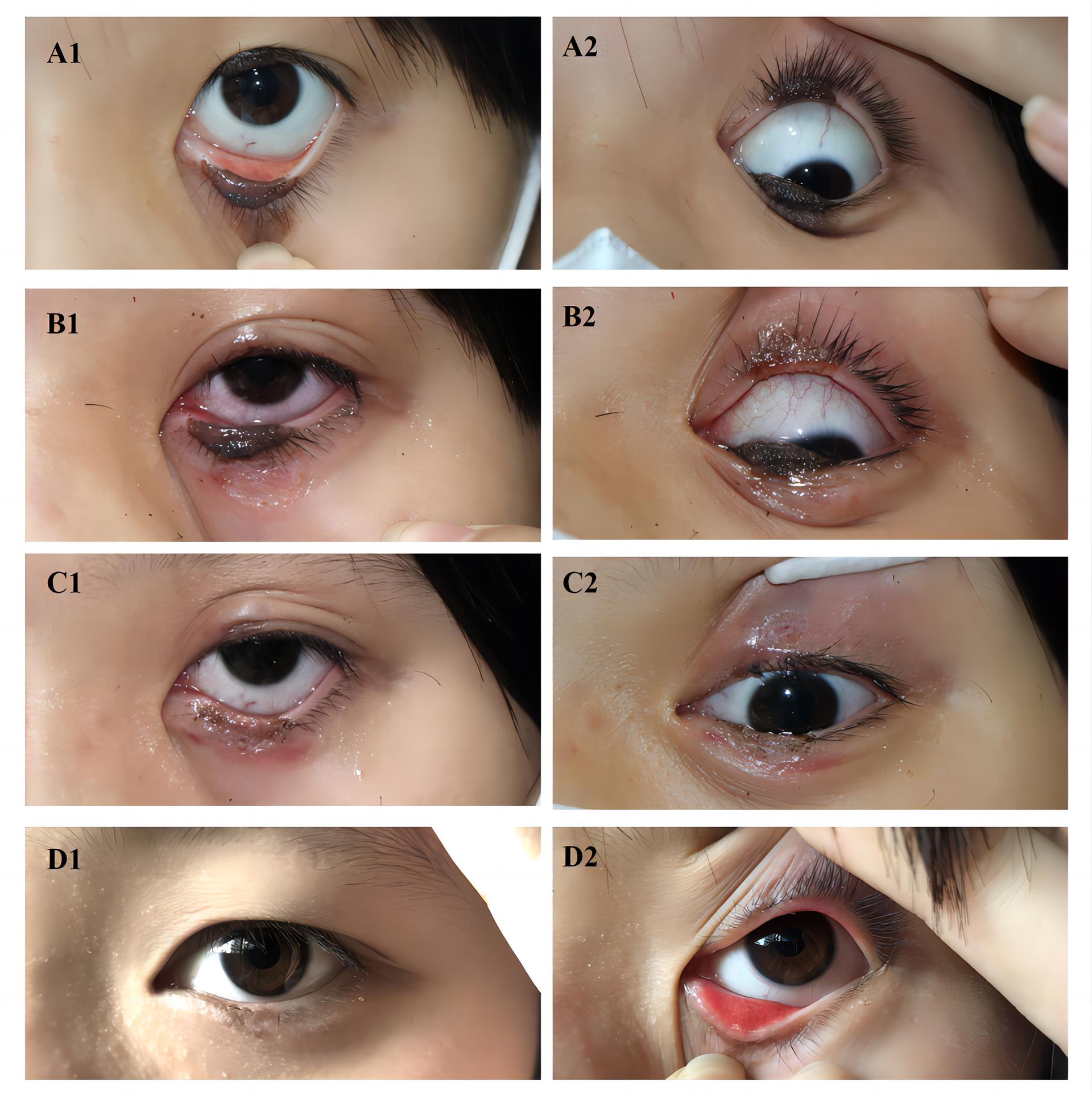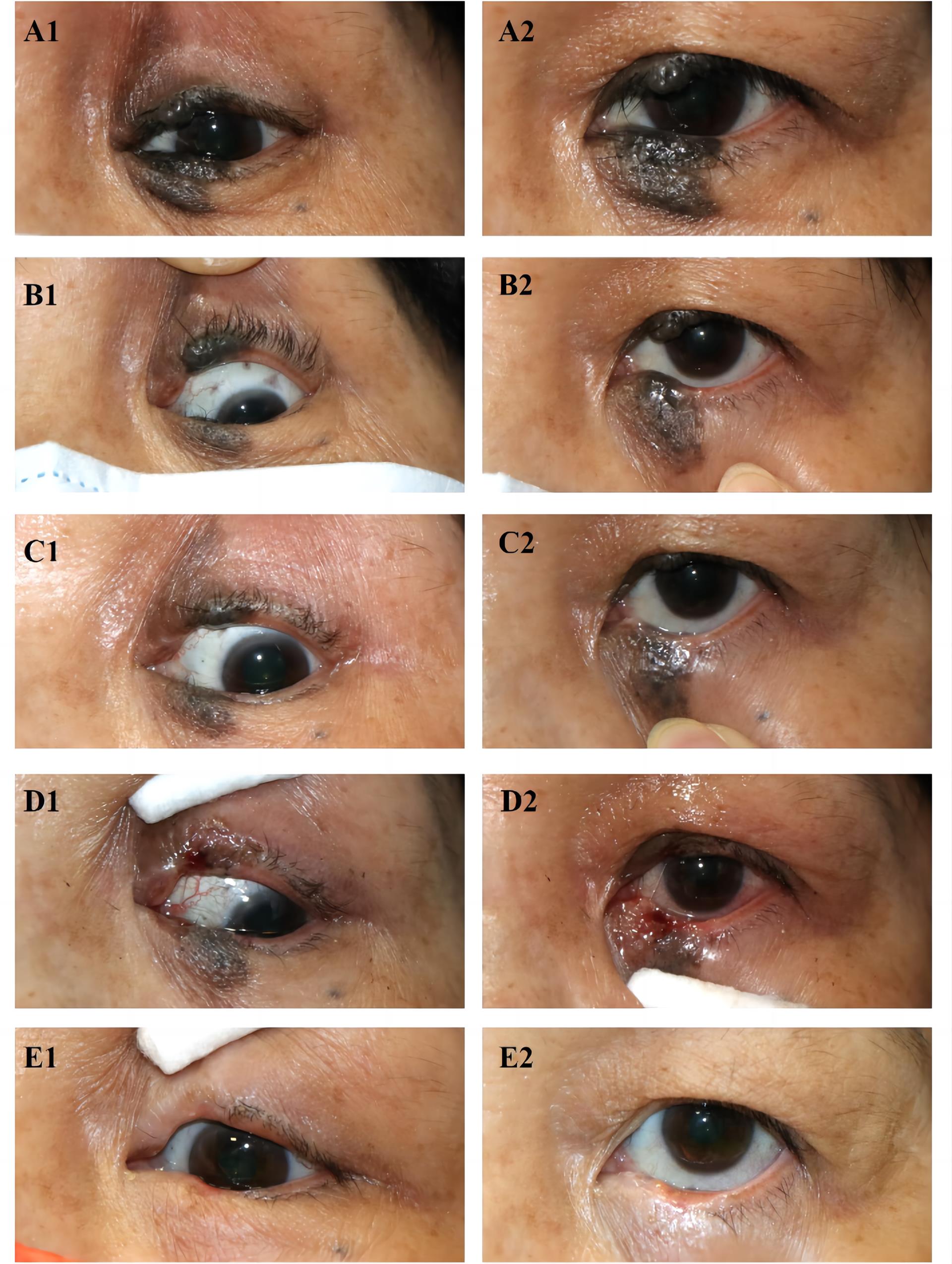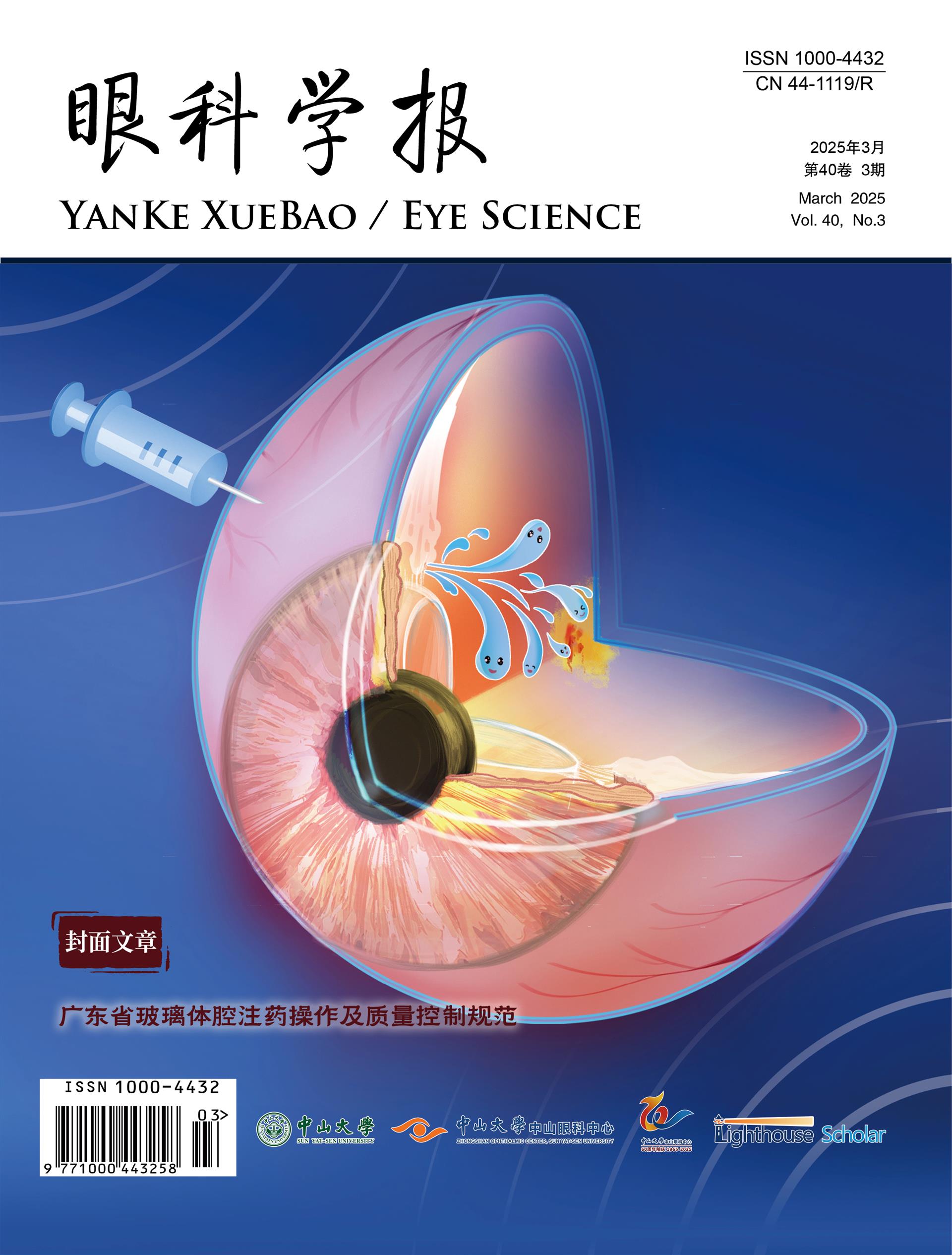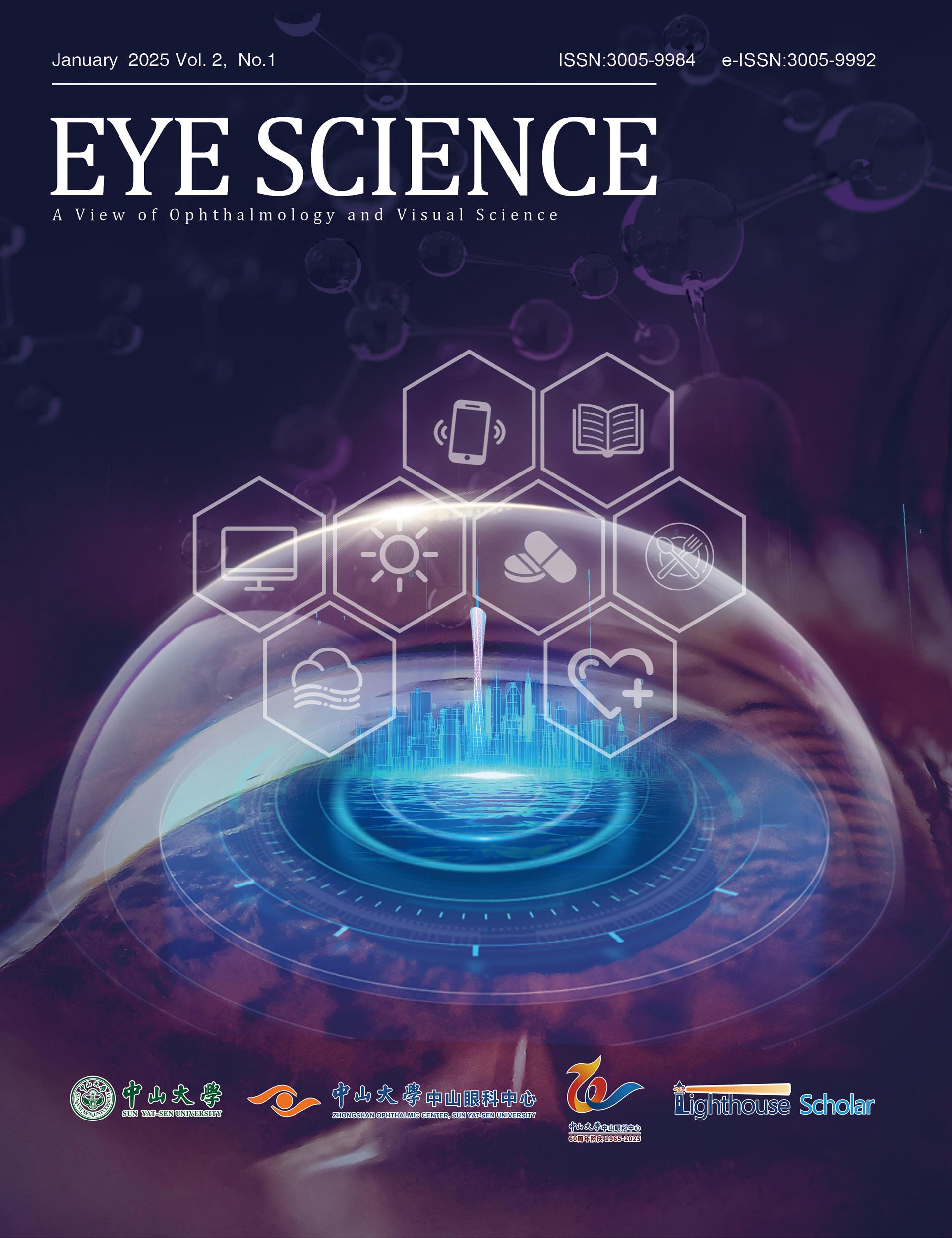1、Desai SC, Walen S, Holds JB, et al. Divided nevus of the
eyelid: review of embryology, pathology and treatment.
AmJOtolaryngol. 2013, 34(3): 223-229. DOI: 10.1016/
j.amjoto.2013.01.004.Desai SC, Walen S, Holds JB, et al. Divided nevus of the
eyelid: review of embryology, pathology and treatment.
AmJOtolaryngol. 2013, 34(3): 223-229. DOI: 10.1016/
j.amjoto.2013.01.004.
2、Papadopoulos O. Divided nevus of the eyelid.
PlastReconstrSurg. 1991, 88(2): 331-333. DOI:
10.1097/00006534-199108000-00028.Papadopoulos O. Divided nevus of the eyelid.
PlastReconstrSurg. 1991, 88(2): 331-333. DOI:
10.1097/00006534-199108000-00028.
3、Yap LH, Earley MJ. The panda naevus: management of
synchronous upper- and lower-eyelid pigmented naevi.
BrJPlastSurg. 2001, 54(2): 102-105. DOI: 10.1054/
bjps.2000.3514.Yap LH, Earley MJ. The panda naevus: management of
synchronous upper- and lower-eyelid pigmented naevi.
BrJPlastSurg. 2001, 54(2): 102-105. DOI: 10.1054/
bjps.2000.3514.
4、Ghosh YK, Abu-Ain M, Ahluwalia HS. One stage
management of a giant kissing naevus. Orbit. 2010, 29(3):
174-175. DOI: 10.3109/01676830903488811.Ghosh YK, Abu-Ain M, Ahluwalia HS. One stage
management of a giant kissing naevus. Orbit. 2010, 29(3):
174-175. DOI: 10.3109/01676830903488811.
5、Marghoob AA, Borrego JP, Halpern AC. Congenital
melanocytic nevi: treatment modalities and management
options. SeminCutanMedSurg. 2007, 26(4): 231-240. DOI:
10.1016/j.sder.2008.03.007.Marghoob AA, Borrego JP, Halpern AC. Congenital
melanocytic nevi: treatment modalities and management
options. SeminCutanMedSurg. 2007, 26(4): 231-240. DOI:
10.1016/j.sder.2008.03.007.
6、Ashfaq I, Kyprianou I, Ahluwalia H. A large kissing
(divided) naevus presenting with complete mechanical
ptosis and lower lid ectropion. JPlastReconstrAesthetSurg.
2009, 62(5): e87-e88. DOI: 10.1016/j.bjps.2008.08.029.Ashfaq I, Kyprianou I, Ahluwalia H. A large kissing
(divided) naevus presenting with complete mechanical
ptosis and lower lid ectropion. JPlastReconstrAesthetSurg.
2009, 62(5): e87-e88. DOI: 10.1016/j.bjps.2008.08.029.
7、Yildirim N, Sahin A, Erol N. The surgical treatment of
congenital divided nevus of the eyelid: a case report and
review of the literature. IntOphthalmol. 2009, 29(1): 45-47.
DOI: 10.1007/s10792-007-9163-5.Yildirim N, Sahin A, Erol N. The surgical treatment of
congenital divided nevus of the eyelid: a case report and
review of the literature. IntOphthalmol. 2009, 29(1): 45-47.
DOI: 10.1007/s10792-007-9163-5.
8、Camargo CP, Saliba M, Saad EA, et al. Treatments of
palpebral congenital melanocytic nevus: a systematic
review. Acta CirBras. 2023, 38: e384823. DOI: 10.1590/
acb384823.Camargo CP, Saliba M, Saad EA, et al. Treatments of
palpebral congenital melanocytic nevus: a systematic
review. Acta CirBras. 2023, 38: e384823. DOI: 10.1590/
acb384823.
9、Liu J, Sun J, Wang Z, et al. Treatment of divided eyelid
nevus with orbicularis oculi myocutaneous flap: report of 17
cases. AnnPlastSurg. 2020, 85(6): 626-630. DOI: 10.1097/
SAP.0000000000002507.Liu J, Sun J, Wang Z, et al. Treatment of divided eyelid
nevus with orbicularis oculi myocutaneous flap: report of 17
cases. AnnPlastSurg. 2020, 85(6): 626-630. DOI: 10.1097/
SAP.0000000000002507.
10、Li J, Wang Y, Li D, et al. Application of allogeneic sclera
combined with tarso-conjunctival flap in total excision of
divided eyelid nevus. JPlastReconstrAesthetSurg. 2022,
75(10): 3789-3794. DOI: 10.1016/j.bjps.2022.06.028.Li J, Wang Y, Li D, et al. Application of allogeneic sclera
combined with tarso-conjunctival flap in total excision of
divided eyelid nevus. JPlastReconstrAesthetSurg. 2022,
75(10): 3789-3794. DOI: 10.1016/j.bjps.2022.06.028.
11、 Papadopoulos O, Chrisostomidis C, Konofaos P,
et al. Divided naevus of the eyelid, seven cases.
JPlastReconstrAesthetSurg. 2007, 60(3): 260-265. DOI:
10.1016/j.bjps.2005.12.032. Papadopoulos O, Chrisostomidis C, Konofaos P,
et al. Divided naevus of the eyelid, seven cases.
JPlastReconstrAesthetSurg. 2007, 60(3): 260-265. DOI:
10.1016/j.bjps.2005.12.032.
12、Jacobs SM, Couch SM, Custer PL. Divided eyelid nevus:
a lid-sparing, staged surgical approach. AmJOphthalmol.
2013, 156(4): 813-818. DOI: 10.1016/j.ajo.2013.05.032.Jacobs SM, Couch SM, Custer PL. Divided eyelid nevus:
a lid-sparing, staged surgical approach. AmJOphthalmol.
2013, 156(4): 813-818. DOI: 10.1016/j.ajo.2013.05.032.
13、 Naik MN, Ali MJ, Kaliki S. Epithelial stripping for
divided (kissing) nevus of the eyelid: aminimally invasive
technique. DermatolSurg. 2020, 46(6): 842-844. DOI:
10.1097/DSS.0000000000001937. Naik MN, Ali MJ, Kaliki S. Epithelial stripping for
divided (kissing) nevus of the eyelid: aminimally invasive
technique. DermatolSurg. 2020, 46(6): 842-844. DOI:
10.1097/DSS.0000000000001937.
14、Klapper S, Patrinely J. Management of cosmetic eyelid
surgery complications. SeminPlastSurg. 2007, 21(1): 80-93.
DOI: 10.1055/s-2007-967753.Klapper S, Patrinely J. Management of cosmetic eyelid
surgery complications. SeminPlastSurg. 2007, 21(1): 80-93.
DOI: 10.1055/s-2007-967753.
15、Carniciu AL, Jovanovic N, Kahana A. Eyelid complications
associated with surgery for periocular cutaneous
malignancies. Facial PlastSurg. 2020, 36(2): 166-175. DOI:
10.1055/s-0040-1709515.Carniciu AL, Jovanovic N, Kahana A. Eyelid complications
associated with surgery for periocular cutaneous
malignancies. Facial PlastSurg. 2020, 36(2): 166-175. DOI:
10.1055/s-0040-1709515.
16、Cho HJ, Lee W, Jeon MK, et al. Staged mosaic punching
excision of a kissing nevus on the eyelid. Aesthetic
PlastSurg. 2019, 43(3): 652-657. DOI: 10.1007/s00266-019-
01362-0.Cho HJ, Lee W, Jeon MK, et al. Staged mosaic punching
excision of a kissing nevus on the eyelid. Aesthetic
PlastSurg. 2019, 43(3): 652-657. DOI: 10.1007/s00266-019-
01362-0.
17、Zeng Y. Divided nevus of the eyelid: successful treatment
with CO2 laser. JDermatologTreat. 2014, 25(4): 358-359.
DOI: 10.3109/09546634.2012.756970.Zeng Y. Divided nevus of the eyelid: successful treatment
with CO2 laser. JDermatologTreat. 2014, 25(4): 358-359.
DOI: 10.3109/09546634.2012.756970.
18、Suzuki A, Yotsuyanagi T, Yamashita K, et al. Reconstruction
of the congenital divided nevus of the eyelids and proposal
of new classification. PlastReconstrSurgGlobOpen. 2019,
7(6): e2283. DOI: 10.1097/GOX.0000000000002283.Suzuki A, Yotsuyanagi T, Yamashita K, et al. Reconstruction
of the congenital divided nevus of the eyelids and proposal
of new classification. PlastReconstrSurgGlobOpen. 2019,
7(6): e2283. DOI: 10.1097/GOX.0000000000002283.
19、Nagamatsu S, Sasaki A, Uchiki T, et al. An angled mirror
device facilitates measurement of skin lesion height.
PlastReconstrSurgGlobOpen. 2020, 8(11): e3233. DOI:
10.1097/GOX.0000000000003233.Nagamatsu S, Sasaki A, Uchiki T, et al. An angled mirror
device facilitates measurement of skin lesion height.
PlastReconstrSurgGlobOpen. 2020, 8(11): e3233. DOI:
10.1097/GOX.0000000000003233.
20、Zloto O, Landau Prat D, Katowitz JA, et al. The surgical
management and outcomes of kissing nevi of the eyelids.
Eye. 2023, 37(14): 3015-3019. DOI: 10.1038/s41433-023-
02463-6.Zloto O, Landau Prat D, Katowitz JA, et al. The surgical
management and outcomes of kissing nevi of the eyelids.
Eye. 2023, 37(14): 3015-3019. DOI: 10.1038/s41433-023-
02463-6.
21、Hu L, Jin Y, Tremp M, et al. Reconstruction of a large
divided nevus of the eyelid. DermatolSurg. 2017, 43(12):
1483-1486. DOI: 10.1097/dss.0000000000000905.Hu L, Jin Y, Tremp M, et al. Reconstruction of a large
divided nevus of the eyelid. DermatolSurg. 2017, 43(12):
1483-1486. DOI: 10.1097/dss.0000000000000905.
22、Zhu L, Qiao Q, Liu Z, et al. Treatment of divided eyelid
nevus with island skin flap: report of ten cases and review of
the literature. Ophthalmic PlastReconstrSurg. 2009, 25(6):
476-480. DOI: 10.1097/IOP.0b013e3181b81eb7.Zhu L, Qiao Q, Liu Z, et al. Treatment of divided eyelid
nevus with island skin flap: report of ten cases and review of
the literature. Ophthalmic PlastReconstrSurg. 2009, 25(6):
476-480. DOI: 10.1097/IOP.0b013e3181b81eb7.
23、Ritz M, Corrigan B. Congenital melanocytic nevi of the
eyelids and periorbital region. PlastReconstrSurg. 2010,
125(5): 1568-1569. DOI: 10.1097/PRS.0b013e3181d512aa.Ritz M, Corrigan B. Congenital melanocytic nevi of the
eyelids and periorbital region. PlastReconstrSurg. 2010,
125(5): 1568-1569. DOI: 10.1097/PRS.0b013e3181d512aa.
24、Zhang X, Tang W, Yi L, et al. Divided eyelid nevus:
surgical repair discussion and case reports from
northwestern China. PlastSurg. 2020, 28(4): 249-253. DOI:
10.1177/2292550320928559.Zhang X, Tang W, Yi L, et al. Divided eyelid nevus:
surgical repair discussion and case reports from
northwestern China. PlastSurg. 2020, 28(4): 249-253. DOI:
10.1177/2292550320928559.
25、%20Lema%C3%AEtre%20S%2C%20Gardrat%20S%2C%20Vincent-Salomon%20A%2C%20et%20al.%20Malignant%20%0Atransformation%20of%20a%20multi-operated%20divided%20nevus%20of%20the%20%0Aeyelids.%20OculOncolPathol.%202018%2C%204(2)%3A%20112-115.%20DOI%3A%20%0A10.1159%2F000479069.%20Lema%C3%AEtre%20S%2C%20Gardrat%20S%2C%20Vincent-Salomon%20A%2C%20et%20al.%20Malignant%20%0Atransformation%20of%20a%20multi-operated%20divided%20nevus%20of%20the%20%0Aeyelids.%20OculOncolPathol.%202018%2C%204(2)%3A%20112-115.%20DOI%3A%20%0A10.1159%2F000479069.



























